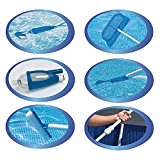
If you have ever been swimming in a pool you should already be aware of the chemical chlorine. Used for sanitation, it is mainly used by water treatment plants and other industries. Used by water treatment plants to clear and sanitize contaminated water and industrial waste water, it plays a vital role in our society. Aside from being used for pool maintenance to keep the water sanitized and free from microbes, it is also used as a bleaching agent and plays a major role in the chemical industry.
The most basic use of chlorine isn’t actually sanitizing pools but in keeping our drinking water safe from bacteria and other microorganisms which are harbingers of disease. During the treatment process, waste water is mixed with chlorine to sterilize it and it undergoes several cycles of purification before it arrives at our sink. While chlorine is an excellent disinfectant, excessive amounts of chlorine in water can result in a milky-white or cloudy substance, which are actually un-dissolved chlorine particles. The second most common use of chlorine is in household cleaners like bleach, detergents, and disinfectants. Of course, there’s pool maintenance too. Used not only to sanitize pool water, chlorination also prevents the production of algae while providing a safe and sterile environment for swimmers.
Despite being one of the most efficient means of pool sanitation, pool maintenance has downsides which must be reduced. In excessive concentrations, chlorine can become a skin and eye irritant. Newer, state-of-the-art pool maintenance systems now have automated sensors which increase or decrease the Ph level and level of chlorine in a pool according to its needs. Lucky for us pool maintenance is now automated, because decades ago pool chlorination was done manually day in and day out. Problems such as scaling, calcified build-up, and even a slow deterioration of pool accessories can happen due to the oxidative nature of chlorine. Many chemical agents are now commonly incorporated into the pool water alongside chlorine, not only for cleanliness and sanitation, but to prevent oxidation and build-up as well.
Although it is very pricey for some, many pool owners are now switching to automated pool maintenance systems for the sheer ease it provides. The most popular type of automated chlorinating system used today is the saltwater pool chlorinator which converts sodium hypochlorite into the chlorine used for pool maintenance. Newer and better pool maintenance systems are continuously being developed in the hopes of one day making a perfect self-maintaining pool cleaning system. Disclaimer: The videos, posts, and comments contained in our *Health & Weight Loss Categories* on this website are not medical advice or a treatment plan and are intended for general education and demonstration purposes only. They should not be used to self-diagnose or self-treat any health, medical, or physical condition. Don’t use this website to avoid going to your own healthcare professional or to replace the advice they give you. Consult with your healthcare professional before doing anything contained on this website.
0 Comments
Leave a Reply. |
|